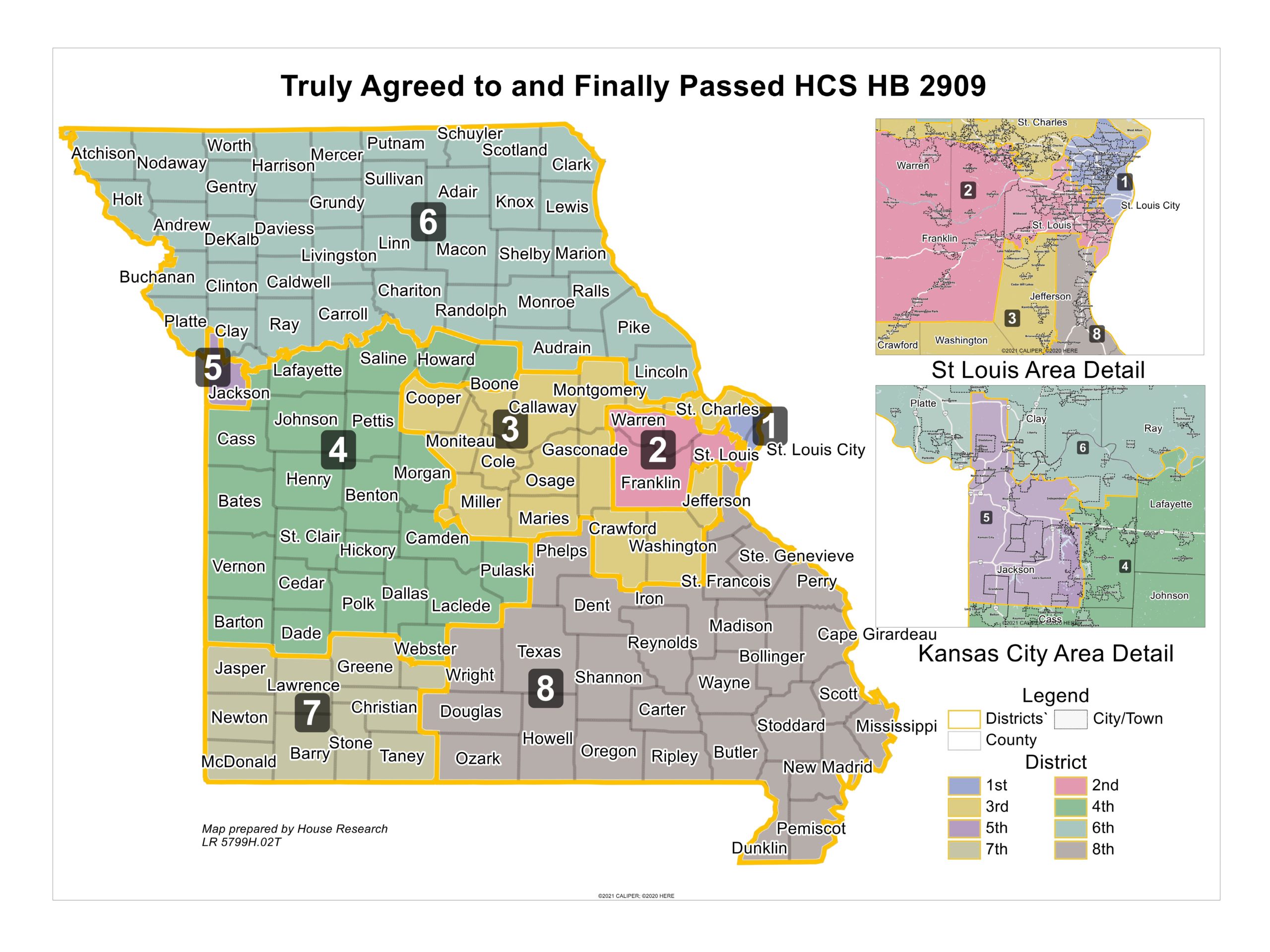Missouri Republicans are once again exploring efforts to redraw the state’s congressional map, a move that, if successful, could shift the balance of power in the state’s U.S. House delegation. Some within the GOP are eyeing a change from Missouri’s current 6-2 Republican-Democrat split to a potential 7-1 advantage, a long-standing objective that appears to be regaining traction with support from former President Donald Trump.
At the center of the discussion is Missouri’s 5th Congressional District, a Democratic stronghold anchored in Kansas City and represented by Congressman Emanuel Cleaver. The emerging strategy: to dilute the district’s Democratic base enough to create an opportunity for Republicans to compete for the seat.
Trump Applies Pressure, GOP Responds
Reports surfaced two weeks ago that Trump’s team has been pressuring Missouri Republicans to revisit the state’s district lines before the 2026 midterms. On July 25, the Missouri Freedom Caucus publicly urged Governor Mike Kehoe to call a special session to redraw the map “consistent with President Trump’s recommendations.” Kehoe has since expressed support for the idea.
Congressman Jason Smith, a close Trump ally, is leading the public charge. “Missouri supports Republican priorities and President Trump,” Smith said. “I welcome my state reps and senators making sure we have a very good congressional map.”
Smith believes a 7-1 map is not only feasible but necessary, criticizing the current lines as overly jagged and inefficient.
Redistricting in the Middle of the Decade?
While redistricting typically follows the U.S. Census every ten years, states can redraw maps mid-decade if political will, or legal orders, demand it. Trump’s team has already targeted Texas for similar changes, and Missouri now appears to be the next battleground.
A successful redraw could flip Cleaver’s 5th District, leaving freshman Congressman Wesley Bell as the lone Democrat in Missouri’s House delegation.
Flashback: The GOP’s 2022 Internal Fight
Missouri’s current 6-2 congressional map resulted from a bruising 2022 redistricting battle that exposed deep divisions within the state’s Republican supermajority. What began as a routine process quickly spiraled into a weeks-long showdown between Senate leadership and the hardline Conservative Caucus.
The House had passed a compromise map preserving the GOP’s 6-2 advantage, but the Conservative Caucus, led by Senators Bob Onder, Bill Eigel, and Denny Hoskins, insisted on a 7-1 map. They argued it was a once-in-a-decade opportunity to eliminate a Democratic seat. Senate leadership, including Majority Leader Caleb Rowden, warned that such a map would overreach, risking legal challenges and future electoral losses.
The impasse led to a 31-hour filibuster, one of the longest in Senate history. Tensions rose as it became clear that several Senators involved in the filibuster, including Rick Brattin, Eric Burlison, and Mike Moon, were also planning to run for Congress. Some colleagues accused them of trying to draw their own districts. Rowden and Onder publicly exchanged accusations of political opportunism.
Senate Democrats also held the floor at times, notably Sen. Steven Roberts, who pushed to redraw the 1st Congressional District to maintain its minority-majority composition under the Voting Rights Act.
With no consensus and the chamber near collapse, Senate leadership ultimately pushed through a compromise 6-2 map.
Fast Forward to Today
Despite Trump’s push and growing support within the Missouri GOP, not every Republican is convinced. Some party leaders recall the failed effort to secure a 7-1 map in 2022, when internal divisions and fears of future backlash led to the current 6-2 map.
Senate President Pro Tem Cindy O’Laughlin acknowledged that no formal discussions have occurred yet but did say that a special session is indeed “likely.”
Former GOP Chair John Hancock warned that an aggressive redraw could trigger a drawn-out legal fight, while Democrats say the move is purely political.
Back to Traditional Democrats vs Republicans
Unlike in 2022, the current Republican majority in the Senate is free of many of the clashing personalities they witnessed three years ago, and recent uses of the Previous Question have put Republicans in the position to possibly use it again. With very little dissent likely to occur on the Republican side, Democrats are the natural opposition.
In usual years, Democrats would mainly claim this to be a power grab on the Republican side, but this year, a new argument seems to be taking shape.
Senate Minority Leader Doug Beck has been accusing Republicans of using redistricting as a distraction from Trump’s legal controversies, including ties to the disgraced financier and child sex offender Jeffrey Epstein. “It’s frustrating. I think a lot of this has to do with the Epstein files,” Beck said. “They’re bowing down to this guy who’s protecting pedophiles.”
Senator Stephen Webber added on last week’s TWMP Daily that the real winner of the redistricting fight will likely be those who were involved in Epstein’s operations.
At the end of the 2025 session, when Republicans dropped not one but two PQs on the opposition, Democrats swore they would cease activity in the chamber in the coming 2026 session, but quickly changed their minds during the summer special session, which passed stadium funding for the Chiefs and Royals as well as St. Louis tornado relief.
What Would a 7-1 Map Look Like?
While no official proposal has been released, two likely scenarios are being discussed:
- Central Missouri Expansion
This version would split Jackson County into three districts, sending portions to the 4th and 6th Districts and extending a reimagined 5th District into central Missouri, possibly including Columbia. It would overlap areas represented by Congressmen Alford and Graves as well as mirror Sen. Kurtis Gregory’s state Senate district. - Northern Suburban Consolidation
Alternatively, a new district could be formed using Platte, Clay, Buchanan, and parts of northern Jackson County, creating a moderate Republican stronghold. This could merge areas currently represented by Senators Luetkemeyer, Nurrenbern, Nicola, and Washington.
Insiders suggest Trump’s team may already have a draft map prepared to present to the General Assembly.
Special Session Expected
A special legislative session focused on redistricting is now seen as very likely. Talks between House and Senate leadership are reportedly set for next week. Some are also pushing to add initiative petition (IP) reform to the agenda, but sources say that’s less probable.
Senator Cierpoit pointed to the possibility that the 2026 Session will provide the opportunity for IP Reform to be looked at.
Who Could Benefit?
If redistricting happens, several Missouri Republicans could emerge as contenders for newly drawn or adjusted congressional seats:
-
- Sen. Tony Luetkemeyer – A potential successor to Rep. Sam Graves, with significant campaign resources already in place.
- Sen. Kurtis Gregory – His Senate district could form the backbone of a new congressional district.
- Speaker Jon Patterson – With strong fundraising and local ties, Patterson is well-positioned if a new district forms in or around Jackson County.
- Sen. Jason Bean – May advocate for a new district in southeastern Missouri, broadening the redistricting conversation beyond Kansas City.
- Sen. Mary Elizabeth Coleman – After a successful 2025 session, Coleman is seen as a rising contender if an opportunity opens.
- Eric Greitens – Greitens always seems to be on the move to make a political comeback. This would be one of the moments to capitalize on.
What’s Next?
The next flashpoint could come during the September veto session, but many expect redistricting to be addressed in a separate special session. Either way, any effort to redraw the lines is likely to provoke intense political debate, and possibly, a court battle.
If Missouri Republicans move forward, they’ll be aligning more tightly than ever with Trump’s broader strategy to secure a GOP-controlled Congress in 2026. But if the past redistricting fight shows anything, they’ll also risk deepening intra-party divides. Some Republicans could even be worried that the possible 7-1 map could lead to Democrats turning it into a 5-3 map in future elections.

Jake Kroesen is a Jackson County native and a graduate of the University of Central Missouri. He holds a B.S. in Political Science.




















